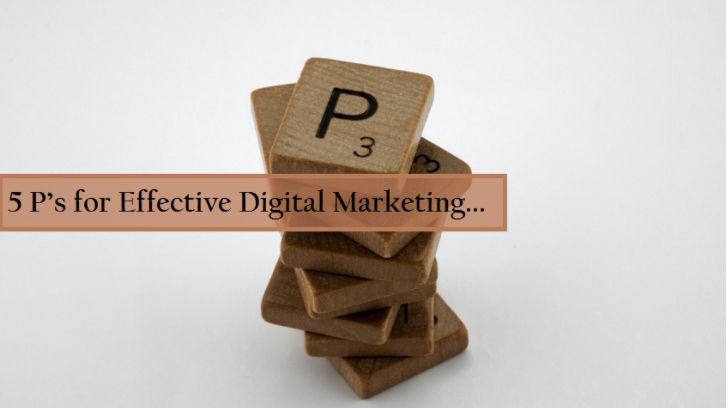The 5 Ps of Marketing, often called ‘marketing mix,’ serve as the foundation for every effective marketing plan.
They are powerful, though not simple to apply. Therefore, it will be challenging to communicate your business without a thorough grasp of all the 5 Ps of marketing.
What’s more? With the 5 Ps of marketing, you will determine which aspects of your business need improvement to satisfy the demands of your customers better.
In fact, the 5 Ps of marketing keep you ahead of your competitors.
In this article, we’ll take a deep dive into the 5 Ps of marketing. So that by the conclusion of this piece, you’ll understand what they represent and why you must be strategic about them when developing your marketing plan.
Table of Contents
The History Of The 5 Ps Of Marketing

At this juncture, you might be wondering who invented the 5 Ps of marketing. Find out more in this section.
Neil Borden invented the phrase “marketing mix” in 1949. Borden was a Harvard Graduate School of Business Administration advertising professor.
He was the first to popularize the 5 Ps of marketing and test them. It was a groundbreaking notion at the time.
And his goal in inventing the 5 Ps of marketing was to produce a marketing formula that everyone could use, from CEOs to small business owners.
E. Jerome McCarthy, a Notre Dame, was a marketing professor and author. He also contributed to the formation of the 5 Ps of marketing.
In 1960, he first developed the notion of the Four P’s of marketing in his book, Basic Marketing: A Managerial Approach. However, the Ps of marketing could be changed in the long term.
Edmund Jerome McCarthy’s strategy encompassed pricing, promotion, product, and place. These are the four most essential aspects of marketing.
What Are The 5 Ps Of Marketing?

The 5 Ps of marketing is a promotional strategy that organizes marketing into essential factors. Such factors are products, pricing, promotion, people, as well as places.
They aid organizations in making accurate product selections and developing a good marketing strategy.
Now, let’s look at the 5 Ps of marketing. So, we can ascertain how each P might help you establish a credible market presence.
1. Product

Getting a grip on your product is one of the 5 Ps of marketing. Thus, you have to examine your product from all angles thoroughly.
After all, the goal of marketing is to increase sales. It implies that you must have a thorough comprehension of the product you’re dealing with.
To help you examine your product, consider the following;
- What makes your product stand out from the competition? What differentiates it from the competition? Can you tweak it if it’s identical to other products? What’s your unique selling proposition (USP)?
- What are the essential features of your products? How does it benefit your audience? Does it solve challenges? Does it save a lot of time? In addition, does it improve lives?
- What does your product look like? How does it feel and taste? What emotional and physical effects do these characteristics have on the customer? Technical specs may be included in these qualities. However, this depends on what you’re offering.
- Is the buyer aware of what you’re offering? Can they recognize your product at first sight? Don’t make it too difficult for them.
- What does your product look like? How does it make customers feel? Recall that your branding is the first thing customers notice. Therefore, the higher the price, the higher the product’s perceived worth. Also, consider the importance of eco-friendly packaging.
- Are you offering an appealing product? Does it meet the desires of your customers? If you’re unsure, use customer surveys to find out.
- In your industry, what are the current trends? The emergence of electric automobiles is a beautiful example of this. Will such developments influence how you promote your products?
- Consider how your item is presented in the marketplace. What’s the perception of your product? Also, where do you fit into the market?
2. Price

Determining the correct pricing for your goods is the second among the 5 Ps of marketing. The first thing you should know is that a product’s pricing is elastic.
Though, the beauty of marketing is that items can be sold for more than they are worth. For instance, expensive goods are frequently thought to be “quality.”
Finally, several factors can affect your product’s price. They include the following:
- What pricing strategies do your competitors use? Do you believe you’ve established a fair price for your goods? Would decreasing or boosting your pricing benefit you? What impact would this have on your product’s market position? How does your price set you apart from the crowd?
- How important are sales promotions and coupons in your pricing strategy? Will these have an impact on your pricing? Can you match and change prices? Do you use or intend to use these tools? In addition, keep in mind that these tools are essentially extra charges. If you decide to offer them, increase your rates.
- What methods do customers use to pay for a product? What types of payment options do you provide? Do you offer credit terms or contracts?
- Is your product backed by a warranty or guarantee? Guarantees and warranties are practical sales tools. Yes, most customers pick a product solely based on its guarantee. These factors may also influence your pricing point.
- Does your product pricing represent their quality?
- Have you considered the entire cost of your business? What’s the cost to make, distribute, or showcase the goods? Consider your delivery costs, staff salary, housing, and other expenses.
3. Promotion

Your promotional efforts are a vital pillar in sales and marketing. First, you must understand that advertising and marketing techniques may practically generate revenue on demand.
Therefore, enhance your bottom line or meet any sales objective with an excellent promotional campaign. When putting up promotions, consider the questions below:
- What form of advertisement do you want to use? There are traditional forms, such as print, radio, tv, direct marketing, and face-to-face sales. In addition, there are digital marketing methods such as social media, email marketing, and internet advertising. Furthermore, you could set up a Facebook profile or an online store for your business. Listing your items in internet stores is another advertising tactic.
- Have you determined your product’s target audience? What are your audience’s desires, interests, demographics, and features? What attracts them? And what are the industry’s most challenging problems? Do you target these folks with your ads?
- Are you reaching your target audience through the advertising channels you’ve chosen? If so, do you have enough consumers to keep your business going? Lastly, avoid promoting on a platform where no one is interested in buying your goods.
- Have you thought about other marketing methods, such as rebranding? And do you have a strategy in place to boost sales? Think about using trade exhibitions, partnerships, freebies, or competitions for promotion.
- Have you thought about how public relations may help your company? Do you have a strategy in place to deal with public relations? Is the general impression of your company beneficial or detrimental? What are your plans for dealing with this?
- Do you maximize your profitability with upsells and cross-promotions? Can these extra features compensate for higher advertising costs?
- Have you estimated your return on investment? Spending money on advertising and not yelling a return is the greatest error one can make. Hence, quantify your ROI for every promotion. It suffices to say that if your promotion isn’t profitable, then change it.
4. Place

The fourth “P” in the 5 Ps of marketing stands for ‘place.’ Marketing experts know that things on the high rack sell far better than those on the bottom. Therefore, if you want to sell something, it must be in the appropriate spot.
It is particularly true if the customer isn’t looking for your product, isn’t sure they want it, or you’ve just launched a new one.
- What is the most efficient approach to selling your goods? How do you intend to get your goods into the arms of customers? Will you use personal retail stores or the internet to distribute your products? Instead, will you use third-party distributors or other methods like trade fairs, workshops, conferences, or mail orders to distribute your products?
- Do you have a strategy to have your items in large stores and other news sources? Do you understand how to promote your items in retailers like Walmart and Target?
- Additionally, timing is also an essential aspect of your overall marketing strategy. Is this the best moment to market your product or service? What recent events or trends should you profit from? Remember, the right mix of these elements may significantly increase your marketing performance.
- Lastly, where are your exhibits or physical locations? Do you plan to construct or open these facilities? What are your plans for doing this? Where do you think your retail locations should be located? Do these locations cover the market?
5. People

Finding great people is the fifth “P” in marketing. In the context of advertising, we aren’t referring to consumers.
People are the staff that manages your company. These employees are essential since they are the ones that engage with clients.
So, it implies that they play a significant part in your marketing activities. And you should include them in your total marketing mix.
Moreso, people in the 5 Ps of marketing, are front-of-house workers, sales clerks, salesmen, service team, and anybody else.
Brand loyalty and user experience are influenced by how these people treat customers.
In fact, this is true if you run a service-based company. Therefore, consider the following:
- Do you have a simple, effective, and transparent customer service process?
- What are your consumers’ thoughts on customer service? Is the quality of service offered satisfactory to them? Do happy consumers arise from the quality of service?
- Are your employees well-dressed? Also, do they have the best approach? Do you reward employees for their performance? Are your employees well-versed in your products? Lastly, can they respond to your consumers’ inquiries?
We know you might be wondering how these work. Don’t worry. The following section shows how to use the 5 Ps of marketing effectively.
How To Put The 5 Ps Of Marketing Into Action

So let’s look into how the 5 Ps of marketing may aid in real-life situations. Assume you have a concept for an app that is an online marketplace for distinctive footwear.
Then, with the support of the 5 Ps of marketing, let’s bring this concept to life and into the online buying industry.
1. Product
Online marketing is evolving. Hence, each product now has its audience. Nevertheless, there is room for unique footwear.
So, bridge the gap in an established market with substantial market possibilities.
2. Price
Your app will not sell the footwear; the customers will. So your pricing job is all about the profit you’ll receive.
What is the reasonable fee that will sustain you in business? How much will cover your marketing costs and appear fair to vendors and buyers? Will you charge buyers or sellers a fee?
3. Promotion
You’ve set a price for your promotion, and you’re nearly good to launch using the app. However, you’ll need to make a demand before going live to build expectations. So, where would you declare that you’ve created the ultimate sneaker app?
You may run Facebook advertisements and target those who search for similar terms. You can reach out to Amazon vendors and eBay accounts who specialize in this field.
In addition, hang banners near businesses that participate in sneaker trading.
4. Place
Where would you put your app? The Google Play Store and the App Store are two safe bets, but will you also have a desktop app?
Because sneakerheads are more likely to use their phones than their computers. Thus, do you believe investing in desktop software will be worthwhile?
5. People
You already have customers in mind. And you know what sneakerheads desire. Thus, it’d be beneficial to create a team that can communicate with your audience.
Don’t keep the team too formal. But ensure you have people with solid nerves on your side.
Other Ps Of Marketing Mix

While these 5 Ps of marketing are the backbone of any marketing plan, there are many other Ps that many marketers include in their marketing mix. However, this depends on the type of business.
Thus, consider dividing a handful of the other Ps into their distinct categories when designing your marketing mix.
Below are other Ps you might want to consider when developing your marketing mix.
1. Process
Processes are all about the steps you take in rendering services to customers. The more exact and flawless your processes are, the more efficiently your staff will carry them out.
In determining your processes, consider how you deliver goods to customers and how they view your products. If you receive many client complaints about the same process, find out the issue and fix it.
2. Physical Evidence
It consists of the physical components of your goods or services that can be delivered to clients. Also, it includes the proof of delivery.
Even though most of what the user is paying for is intangible, almost all services involve some physical aspects.
For instance, a hair shop would provide its clients with a finished hairstyle.
However, an insurance agency would give their consumers printed paperwork. In this view, even if the content is not physically printed (PDFs), customers will still receive a “physical product.”
3. Partners
If you have a working relationship with marketing partners, you may want to explore people beyond your corporate network in your marketing strategy.
4. Payment
Payment relates to how you store and handle all of your monetary transactions. Considering the effect that payments have on conversion rate, it is part of the other Ps of marketing.
5. Packaging
Often, it is called “physical evidence.” In a saturated marketplace, a firm’s packaging attracts new consumers.
And it also reaffirms value for current customers. An intelligent design makes it easier for customers to identify your business at a glance.
Also, it may emphasize specific characteristics of your product. For instance, if you own a hair brand, indicate unique hair kinds with various colours on the wrap.
6. Perception
Perception is how your customers perceive your brand. Your brand’s image is an essential feature of current digital marketing tactics. It is a vital component in fundamental marketing Structures.
Importance Of 5 P’s of Marketing to Your Digital Strategy

The marketing mix has various advantages that make it valuable to your digital strategy.
- It aids in understanding what your product or service can provide to your customers.
- The 5 Ps of marketing help you plan a successful product offering.
- It helps in the conception, development, and execution of effective marketing campaigns.
- It allows organizations to capitalize on their strengths while avoiding needless expenditures.
- Assist in determining whether your product or service is appropriate for your clients.
- The 5 Ps of marketing identify consumer requirements.
- It helps you know when and how to market your product or service to your clients.
Frequently Asked Questions
What Does The 5 Ps Of Marketing Stand For?
5Ps of marketing stands for Product, Price, Promotion, Place, and People.
Who Invented The 5 Ps Of Marketing?
Edmund Jerome McCarthy, a professor and novelist invented the 5 Ps of marketing.
What Are The 5 Ps In Sales?
The five Ps in sales are; preparation, plan, process, production, and performance. These are vital factors for your individual sales journey because they generate a broader path to a successful CRM approach.
What Are The 5 Marketing Concepts?
The five marketing concepts firms incorporate; are production, product, selling, marketing, and societal marketing concepts.
What Are The 5 Marketing Processes?
Marketing processes are activities that enable firms to discover consumer issues. It examines market prospects and generates marketing materials to reach the target audience.
Here are the five marketing processes;
i. Mission
ii. Situation Analysis
iii. Marketing Strategy/Planning
iv. Marketing Mix
v. Implementation and Control
Final Thoughts
Incorporating the 5 Ps of marketing into your decision process will result in a vital marketing plan for your organization.
The 5 Ps of marketing have numerous benefits. Thus, businesses that know how to connect the dots can stay ahead of their competitors using excellent marketing strategies (5 Ps of marketing).




